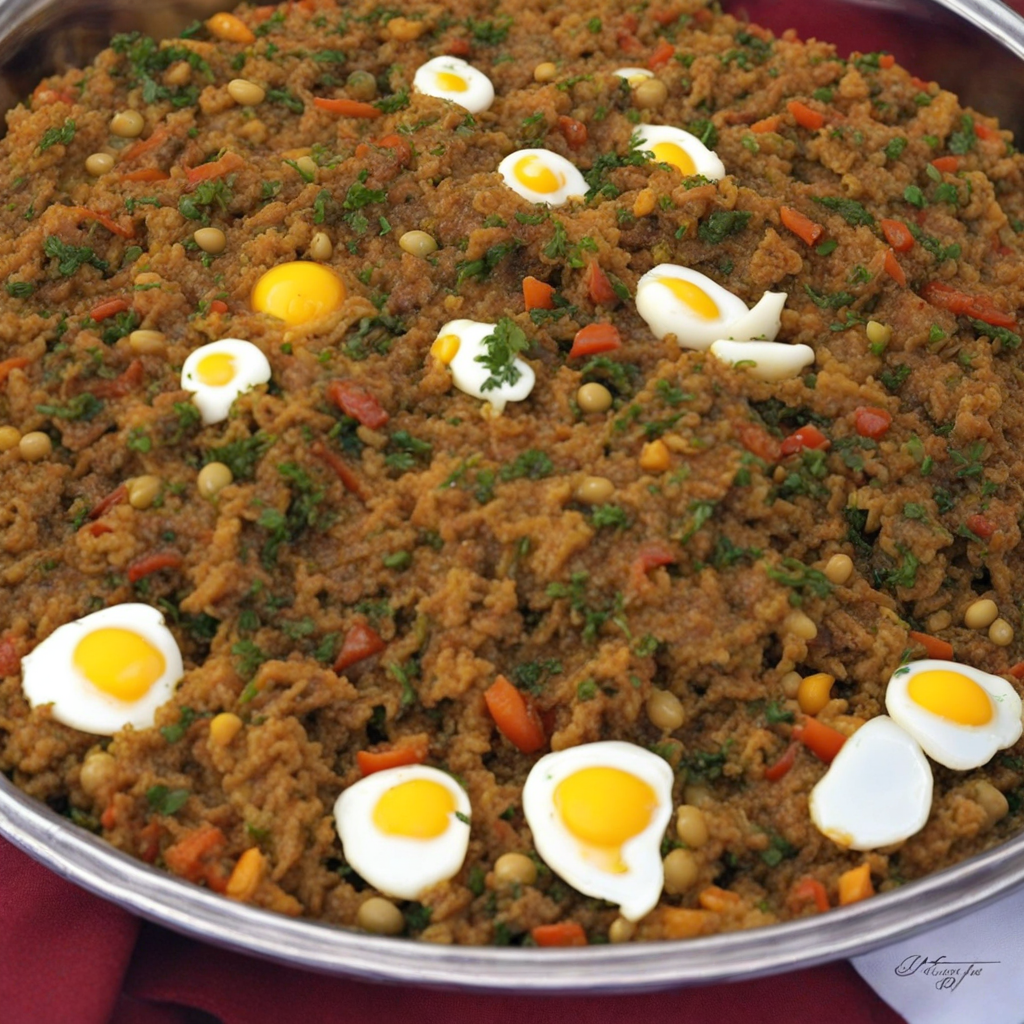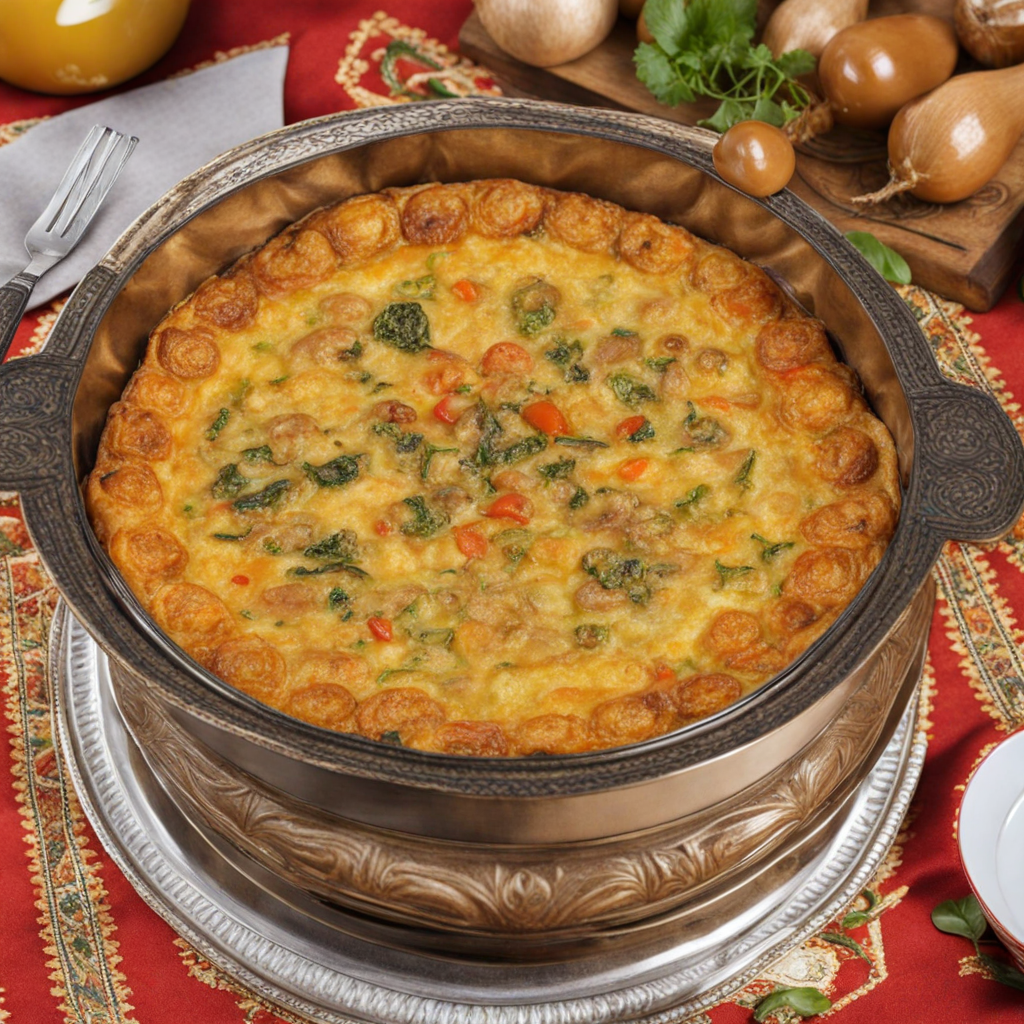Kafteji
Kafteji is a vibrant and flavorful dish that embodies the essence of Tunisian cuisine, often enjoyed as a hearty breakfast or a satisfying snack. This dish typically features a medley of sautéed vegetables, including bell peppers, potatoes, and zucchini, which are diced and cooked to perfection. The vegetables are often seasoned with a blend of spices that may include cumin, coriander, and harissa, lending a warm and slightly spicy kick that is characteristic of North African flavors. The colorful presentation of Kafteji, with its bright vegetables, makes it as appealing to the eye as it is to the palate. To elevate the dish, Kafteji is often enriched with eggs, which are either scrambled directly into the vegetable mixture or fried and served on top, creating a delightful combination of textures. The addition of eggs not only enhances the flavor but also adds a creamy richness that balances the spiciness of the vegetables. Some variations may include the use of tuna, which provides a savory depth and a unique twist to the traditional recipe, making each bite a delightful surprise. Served hot, Kafteji is typically accompanied by crusty bread, perfect for scooping up the colorful mixture. This dish is not just a meal; it represents a tapestry of Tunisian culture, where the use of fresh, local ingredients and bold spices creates a dish that is both comforting and invigorating. Whether enjoyed at a bustling market or in the warmth of a family kitchen, Kafteji invites you to experience the rich culinary heritage of Tunisia, making it a must-try for anyone looking to explore new flavors.
How It Became This Dish
Keftaji: A Culinary Journey Through Tunisia Keftaji, a beloved dish hailing from the shores of Tunisia, is more than just a meal; it is a vibrant symbol of the country’s rich culinary heritage and diverse cultural influences. To fully appreciate Keftaji, one must delve into its origins, cultural significance, and its evolution over time. Origins of Keftaji The roots of Keftaji can be traced back to the rich tapestry of North African cuisine, a culinary landscape that has been shaped by centuries of historical events, trade, and cultural exchanges. The dish is believed to have originated during the Ottoman period, a time when Tunisia was an integral part of the Ottoman Empire. The Ottomans introduced various spices and cooking techniques that have continued to influence Tunisian cuisine. Keftaji itself is a type of dish that features minced meat, usually lamb or beef, combined with a medley of vegetables and spices. The name "Keftaji" derives from the Arabic word "kefteh," which refers to ground meat. Traditionally, the dish is prepared by mixing the minced meat with ingredients such as onions, garlic, bell peppers, and spices like cumin, coriander, and chili powder. This mixture is then shaped into patties or balls and either fried or grilled. Cultural Significance Keftaji holds a special place in Tunisian culture, particularly as a comfort food that evokes a sense of nostalgia and home. It is often associated with family gatherings, celebrations, and communal meals. The preparation of Keftaji is typically a family affair, where members come together to create the dish, sharing stories and laughter along the way. This communal aspect highlights the importance of food in fostering social bonds and creating lasting memories. In Tunisia, food is not merely sustenance; it is a reflection of identity, tradition, and hospitality. Keftaji exemplifies this ethos, as it is often served during festive occasions, such as weddings and religious celebrations. During Ramadan, for instance, families may prepare Keftaji as part of the iftar meal, breaking their fast with this hearty dish that symbolizes abundance and togetherness. Development Over Time As Tunisia has evolved, so too has Keftaji. The dish has undergone various transformations, influenced by both local ingredients and international culinary trends. In the early 20th century, for example, the introduction of new vegetables and spices from Europe and the Americas began to alter traditional recipes. The use of potatoes, zucchini, and even cheese has become more common, reflecting the changing palate of the Tunisian people. The global diaspora of Tunisians has also played a significant role in the evolution of Keftaji. As Tunisians migrated to different parts of the world, they took their culinary traditions with them, adapting recipes to fit the availability of ingredients in their new homes. In countries such as France, where there is a significant Tunisian community, Keftaji has found its way onto restaurant menus, often reimagined to cater to local tastes while still honoring its roots. In recent years, there has been a renewed interest in traditional Tunisian cuisine, spurred by the global trend of seeking authentic culinary experiences. Chefs and home cooks alike have begun to explore and celebrate the flavors and techniques of Tunisia, leading to a resurgence of popularity for dishes like Keftaji. This revival has not only revitalized interest in the dish but has also encouraged a new generation to learn about their culinary heritage. Preparing Keftaji: A Culinary Experience Preparing Keftaji is an art form that reflects the heart of Tunisian cooking. The process begins with the selection of high-quality minced meat, which is often sourced from local markets. Fresh vegetables, such as bell peppers, tomatoes, and onions, are chopped and sautéed, infusing the dish with flavor and texture. The meat is then combined with the sautéed vegetables, along with a blend of spices that may vary from one household to another, as each family has its own secret recipe. After mixing the ingredients, the mixture is shaped into patties or balls, which can be either fried to a golden crisp or grilled for a smoky flavor. The cooking method often depends on personal preference and tradition. In some regions, Keftaji may even be baked, resulting in a healthier variant of the dish. Keftaji is typically served with a tangy sauce made from tomatoes, garlic, and spices, which complements the rich flavors of the meat. It is often accompanied by bread, rice, or couscous, allowing diners to savor every bite. The dish’s versatility means that it can be enjoyed as a main course or as part of a larger spread of Tunisian mezze, which includes an array of appetizers and small plates. Modern Interpretations and Global Influence Today, Keftaji has transcended its traditional boundaries. Chefs are experimenting with the dish, incorporating influences from around the world while maintaining its core essence. Vegetarian adaptations of Keftaji have emerged, utilizing lentils or chickpeas as a base, catering to the growing demand for plant-based options. These modern interpretations have allowed Keftaji to appeal to a broader audience, ensuring its relevance in a rapidly changing culinary landscape. Moreover, the rise of social media and food blogging has played a significant role in promoting Keftaji and other Tunisian dishes to a global audience. Food enthusiasts are sharing their experiences, recipes, and photographs, creating a buzz around Tunisian cuisine and inspiring others to explore its rich flavors. Conclusion Keftaji is not just a dish; it is a tapestry woven with the threads of history, culture, and community. Its origins reflect the diverse influences that have shaped Tunisian cuisine, while its cultural significance underscores the role of food in nurturing relationships and preserving traditions. As Keftaji continues to evolve, it remains a beloved staple that connects generations and transcends borders, inviting all who partake in its flavors to experience the warmth and hospitality of Tunisia. Whether enjoyed in a bustling market in Tunis or a cozy kitchen abroad, Keftaji is a culinary journey that celebrates the heart and soul of Tunisian culture.
You may like
Discover local flavors from Tunisia







